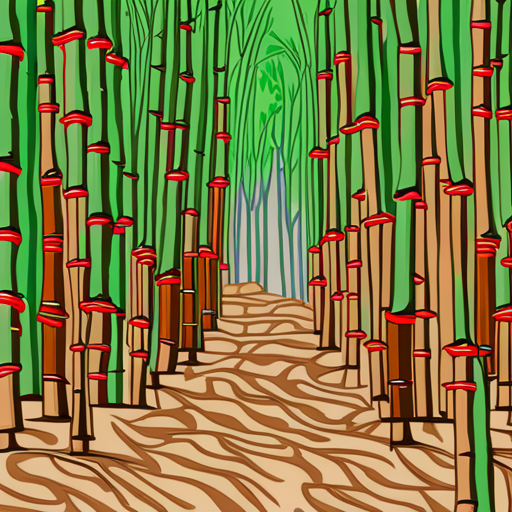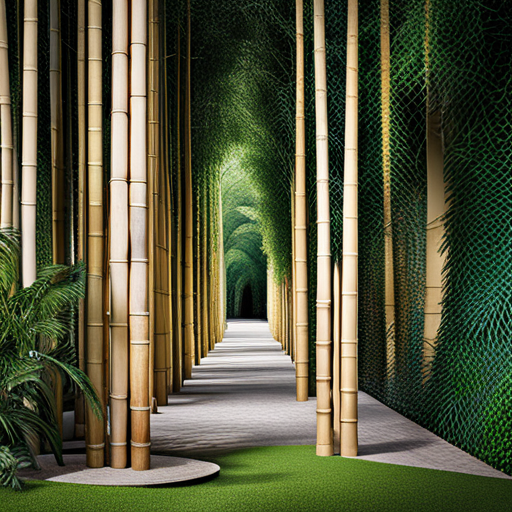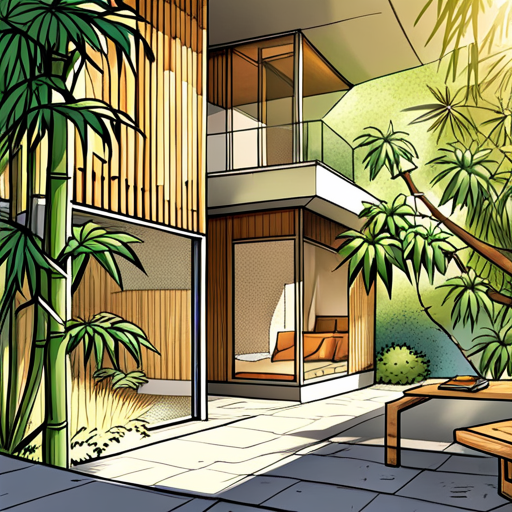Contents
- 1 Bamboos: Versatile Grasses For Construction, Privacy, And More
- 1.1 Our Highlighted Points
- 1.2 What are Bamboos?
- 1.3 Growth and Reproduction
- 1.4 Various Uses
- 1.5 What are the different uses of bamboo in construction and privacy?
- 1.6 Frequently Asked Questions
- 1.6.1 How can I care for outdoor bamboo to prevent it from dying?
- 1.6.2 What specific care does Bissetii bamboo require?
- 1.6.3 Which bamboo species are non-invasive and suitable for clumping?
- 1.6.4 What factors should I consider when choosing a bamboo species for privacy?
- 1.6.5 Are there any cold hardy bamboo species that can thrive in Zone 4 climates?
Bamboos: Versatile Grasses For Construction, Privacy, And More
Bamboos, perennial flowering plants in the grass family Poaceae, are versatile grasses that offer a multitude of benefits in construction, privacy, and various other applications. Despite their resemblance to trees in size and appearance, bamboos are actually evergreen grasses.
Their growth pattern is unique, as bamboo culms shoot up from underground rhizomes and reach their maximum height and diameter within a single growing season. Bamboos are economically significant, providing staple foods for humans and being utilized in feeding and raising meat-producing animals. Additionally, they are extensively used in construction, providing materials such as thatch and straw.
When selecting bamboo species, it is crucial to consider factors like privacy requirements and climate suitability, especially for those residing in Zone 4 climates where cold hardy bamboo species are suitable. Overall, bamboos are invaluable grasses with their versatility and diverse applications across various industries.
Our Highlighted Points
- Bamboos are perennial flowering plants in the grass family Poaceae and are not actually trees.
- Bamboo culms are hollow between the nodes and do not have dense woody tissue like trees.
- Bamboo can be marketed as bamboo trees due to its resemblance to wood, but it is actually an evergreen grass.
- Bamboo is versatile and has numerous uses in construction, providing privacy, and various industries.
What are Bamboos?

Bamboos, which are perennial flowering plants in the subfamily Bambusoideae of the grass family Poaceae, are versatile grasses that can be used for construction, privacy, and various other purposes.
Bamboo is considered a sustainable material for construction due to its rapid growth and renewable nature. It has a high strength-to-weight ratio and can be used to make a wide range of structural components, such as beams, columns, and flooring. Additionally, bamboo has excellent durability and resistance to pests, making it an ideal choice for outdoor structures.
The use of bamboo in construction also offers environmental benefits, as it absorbs high levels of carbon dioxide and releases a significant amount of oxygen during its growth. Furthermore, bamboo cultivation requires less water and pesticides compared to other building materials, making it an eco-friendly alternative for sustainable construction practices.
Growth and Reproduction

The growth and reproductive process of bamboos is unique and different from that of traditional trees. Bamboo cultivation is primarily achieved through rhizome propagation, where new shoots grow from underground rhizomes and emerge as culms above the ground. Unlike trees, bamboos do not have a centralized trunk that expands in girth over time. Instead, their culms shoot up from the rhizomes and reach their maximum height and diameter in a single growing season. Once mature, the culms do not grow wider or taller. This growth pattern is distinct from trees, which continue to increase in size over many years. Additionally, bamboo culms are hollow between the nodes, further distinguishing them from the dense woody tissue found in tree trunks. The table below highlights the differences in growth and reproductive characteristics between bamboos and trees.
| Bamboos | Trees |
|---|---|
| Rhizome propagation | Seed propagation |
| Culms shoot up from rhizomes | Trunks grow from a central point |
| Culms reach maximum height and diameter in one growing season | Trunks continue to grow wider and taller over many years |
| Culms are hollow between nodes | Trunks have dense woody tissue |
| Lack of centralized trunk | Centralized trunk expands in girth over time |
This unique growth and reproductive process makes bamboos versatile and suitable for various purposes, including construction, privacy screens, and more.
Various Uses

One of the main advantages of utilizing bamboo is its wide range of applications. Bamboo has proven to be a versatile material that can be used in various industries, including architecture and construction. It is increasingly being recognized as an eco-friendly alternative to traditional building materials like wood and concrete.
Uses in architecture:
- Bamboo is commonly used in the construction of houses, bridges, and other structures. It is lightweight, yet strong and durable, making it an ideal material for building frameworks and support structures.
- Bamboo can also be used for flooring, roofing, and wall panels, adding a natural and aesthetic appeal to architectural designs.
Eco-friendly alternatives:
- Bamboo is a sustainable and renewable resource. It grows rapidly, with some species being able to reach maturity within a few years. This makes it an excellent alternative to wood, which takes much longer to grow and regenerate.
- Additionally, bamboo cultivation requires fewer resources and is less damaging to the environment compared to other building materials. It also has a lower carbon footprint, making it a popular choice for eco-conscious builders and homeowners.
What are the different uses of bamboo in construction and privacy?
Bamboo is a popular material for construction and privacy screens due to its versatile uses of bamboo. It can be used for building homes, creating fences, and making privacy panels. Its strength and flexibility make it a sustainable and eco-friendly choice for various construction and privacy needs.
Frequently Asked Questions
How can I care for outdoor bamboo to prevent it from dying?
To prevent outdoor bamboo from dying, proper care is essential. Ensure that the bamboo receives adequate sunlight and water, as well as well-drained soil. Regularly prune and remove dead or damaged culms, and protect the bamboo from extreme temperatures and pests.
What specific care does Bissetii bamboo require?
Bissetii bamboo requires specific care for successful growth. Some tips for growing Bissetii bamboo include providing well-drained soil, regular watering, and applying a balanced fertilizer. It is also important to monitor for pests and diseases.
Which bamboo species are non-invasive and suitable for clumping?
Non-invasive bamboo species that are suitable for clumping include Bambusa multiplex, Fargesia nitida, and Chusquea culeou. These species do not spread aggressively and form dense clumps, making them ideal for privacy screens and landscaping purposes.
What factors should I consider when choosing a bamboo species for privacy?
Factors to consider when choosing a bamboo species for privacy include growth rate and height, foliage density, and adaptability to your climate. These factors will determine how quickly and densely the bamboo will provide the desired privacy in your specific environment.
Are there any cold hardy bamboo species that can thrive in Zone 4 climates?
Yes, there are cold hardy bamboo species that can thrive in Zone 4 climates. These species offer benefits such as providing privacy, acting as a windbreak, and adding aesthetic value to gardens, while also being able to withstand the colder temperatures of Zone 4 climates.

